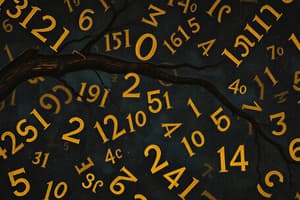Podcast
Questions and Answers
What is the definition of complex numbers?
What is the definition of complex numbers?
- a+bi
- a+bi, a-bi (correct)
- a-bi
- a-b
What are the conjugates of 2-5i?
What are the conjugates of 2-5i?
2+5i
What is a double root?
What is a double root?
An equation with two identical factors, e.g., (x-7)^2
What does the Remainder Theorem state?
What does the Remainder Theorem state?
If and only if ________, then _____ is a factor of ___ and ___ is a root of P(x)=0.
If and only if ________, then _____ is a factor of ___ and ___ is a root of P(x)=0.
What does the Fundamental Theorem of Algebra state?
What does the Fundamental Theorem of Algebra state?
What does the Conjugate Pairs Theorem state?
What does the Conjugate Pairs Theorem state?
What does the Rational Zeros Theorem define?
What does the Rational Zeros Theorem define?
What is the significance of c when a polynomial has a factor (x-c)^n?
What is the significance of c when a polynomial has a factor (x-c)^n?
What does Descartes' Rule of Signs provide information about?
What does Descartes' Rule of Signs provide information about?
What is the number of positive real roots equal to?
What is the number of positive real roots equal to?
How is the number of negative real roots determined?
How is the number of negative real roots determined?
What are imaginary roots?
What are imaginary roots?
Why is the Theorem on Bounds important?
Why is the Theorem on Bounds important?
If r is positive and the numbers in the last row of synthetic division are positive, what can be said about r?
If r is positive and the numbers in the last row of synthetic division are positive, what can be said about r?
What does it mean if no root is greater than r?
What does it mean if no root is greater than r?
If r is negative and the numbers in the last row of synthetic division are alternatively positive and negative, what does this imply?
If r is negative and the numbers in the last row of synthetic division are alternatively positive and negative, what does this imply?
What defines an even function?
What defines an even function?
Even functions are symmetric about which axis?
Even functions are symmetric about which axis?
What defines an odd function?
What defines an odd function?
Odd functions are symmetric about which point?
Odd functions are symmetric about which point?
If the largest exponent in y=f(x) is even, what happens to the two ends of the graph?
If the largest exponent in y=f(x) is even, what happens to the two ends of the graph?
If all exponents in y=f(x) are even numbers, how is the graph positioned?
If all exponents in y=f(x) are even numbers, how is the graph positioned?
If all exponents in y=f(x) are odd numbers and there is no constant term, what can be said about the graph?
If all exponents in y=f(x) are odd numbers and there is no constant term, what can be said about the graph?
In the complex number system, what does a polynomial function of degree n greater than or equal to 1 have?
In the complex number system, what does a polynomial function of degree n greater than or equal to 1 have?
What is the iterative process used for?
What is the iterative process used for?
What does the Intermediate Value Theorem state?
What does the Intermediate Value Theorem state?
Flashcards are hidden until you start studying
Study Notes
Complex Numbers and Conjugates
- Complex numbers take the form ( a + bi ) where ( a ) and ( b ) are real numbers and ( i ) is the imaginary unit.
- The conjugate of a complex number ( a + bi ) is ( a - bi ), and vice versa.
Roots and Factors
- A double root occurs when an equation has two identical factors, exemplified by ( (x - 7)^2 ).
- The Remainder Theorem states that the remainder from dividing ( P(x) ) by ( x - c ) is equal to ( P(c) ).
- According to the Factor Theorem, ( P(c) = 0 ) indicates that ( x - c ) is a factor of ( P(x) ) and ( c ) is a root.
Polynomial Theorems
- The Fundamental Theorem of Algebra asserts every polynomial of degree ( n ) has exactly ( n ) zeros.
- The Conjugate Pairs Theorem states that if ( a + bi ) is a zero of a polynomial, then ( a - bi ) is also a zero.
Zeros and Roots
- The Rational Zeros Theorem suggests that if the coefficient of ( x^n ) is ( 1 ), then the roots are factors of the constant term in the polynomial.
- A polynomial with a factor ( (x - c)^n ) indicates ( c ) has a multiplicity of ( n ) as a zero.
Root Analysis
- Descartes' Rule of Signs helps determine the number and location of real roots of a polynomial equation.
- The number of positive real roots corresponds to the number of sign variations in the polynomial function.
- The number of negative real roots is found by examining the variations in sign for ( P(-x) ).
Root Behavior and Boundaries
- Imaginary roots refer to any remaining roots that are not purely positive or negative.
- The Theorem on Bounds helps identify potential roots by setting upper and lower limits.
- If ( r ) is a positive number and all values in synthetic division's last row are positive, then ( r ) is confirmed as an upper bound.
Function Symmetry and Behavior
- Even functions satisfy the equation ( f(-x) = f(x) ) and show symmetry about the y-axis.
- Odd functions meet the condition ( f(-x) = -f(x) ) and exhibit symmetry about the origin.
- When the highest exponent in ( y = f(x) ) is even, the graph's ends point in the same direction.
Graphical Attributes
- If all exponents in ( y = f(x) ) are even, the function is symmetric regarding the y-axis.
- A function with all odd exponents and no constant term is symmetric about the origin.
Complex Polynomials
- In the complex number system, any polynomial function of degree ( n ) (where ( n \geq 1 )) will have at least one zero.
Estimation Processes
- The iterative process is a method used for estimating irrational zeros of polynomials.
- The Intermediate Value Theorem states that for any value ( a ) between ( f(x_1) ) and ( f(x_2) ), there exists at least one ( c ) in the interval where ( f(c) = a ).
Studying That Suits You
Use AI to generate personalized quizzes and flashcards to suit your learning preferences.




